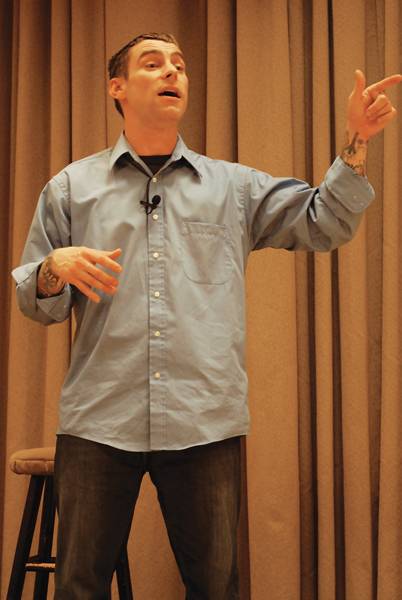Former white supremacist speaks on solidarity, recovery

Frank Meeink is the founder of the Hockey for Harmony Foundation, which encourages youth of all races to play hockey. Frank Meeink spoke about his descent into America’s Nazi underground and his ultimate triumphed over hatred and addiction at Sun Room, MU, March 30, 2010. Photo: Yue Wu/Iowa State Daily
April 1, 2010
Frank Meeink spoke to a crowd Tuesday in the Sun Room of the Memorial Union about his journey into and out of a skinhead group. This lecture was a part of promoting his autobiography entitled “Autobiography of a Recovering Skin Head.” Despite his harsh life story, Meeink mixed heartache and hate with laughter and honesty.
Meeink grew up in south Philadelphia with his mother. Life was decent until his mother starting dating a man known as John.
This man would abuse Meeink for the littlest of things, to the point where Meeink said, “I would go home and I wish I got hit by a car, not die, but I just didn’t want to go home.”
Visiting his older cousin, whom he looked up to, he noticed a change one summer. His cousin had become a skinhead and a neo-Nazi. Meeink at the time didn’t know what a neo-Nazi was, but hung out with his cousin and his new skinhead friends.
The skinheads seemed mostly normal to Meeink despite their comments such as, “Multiracial societies will never work.” They asked him about his life in south Philadelphia, where he was one of 20 white boys in a predominantly black school, as well as including him in their activities
For Meeink, this was one of the reasons he became a skinhead. “For the first time in a long time, someone asked how my day went,” he said.
These friendships continued until one night at a concert, where the skinheads and Meeink began starting fights with other people for no reason.
Once kicked out of the concert, the people they fought with wanted little to do with the skinheads, afraid of what else would happen. “I loved the feeling of being on the other side of the ass whooping,” Meeink said.
Afterward, the group of skinheads shaved his head one strip at a time. Just like that, Meeink became a skinhead like his cousin and friends. He was just 13.
Once back home, Meeink recruited his friends and gained supporters for skinheads. In trouble with the law for his violence, a warrant for his arrest came at age 16.
Meeink went from safe house to safe house to avoid the police.
This didn’t stop his behavior, and as he hid throughout Illinois he continued to recruit and rally support for skinheads. Meeink even created a public access show to promote the cause and beliefs of skinheads. Meeink’s group in Illinois grew in number and popularity.
After kidnapping and beating a different type of skinhead to avoid losing members, Meeink found himself arrested while on the set of his public access show. He was 18 years old.
While in jail, his perspective began to change on race and the values he had as a skinhead. Meeink began rereading the Bible and going to a Bible study composed of all African-Americans.
Meeink cried on the shoulder of a Latina friend when one of his cousins died. He played football with a group of racially mixed men and became good friends with them.
Still he continued to associate with skinheads and those who believed Aryans were the superior race. Once Meeink was out of prison, he continued to recruit and be an active member of the skinhead movement.
Yet Meeink was still being bombarded with people who influenced his life that were of different races. He worked for a Jewish man when no one else would hire him, and they became good friends. Also, he was continually remembering the people he met in prison and the bond they had.
Eventually Meeink realized that being a skinhead wasn’t right for him anymore.
“God was tearing down my stereotypes one by one and telling me, ‘Who are you to judge?’” Meeink said. By interacting with the people he was supposed to hate, he realized that the stereotypes given were not only untrue but were due to his own lack of knowledge.
Meeink summed it up when he said, “You hate what you don’t know.”
Despite Meeink no longer being a skinhead, he still lived a troubled life battling his drug and alcohol abuse.
After numerous stays in rehab, Meeink talked to civil rights groups, such as the Anti-Defamation League, and talked to children and adults about his life and things he has done to help teach them about racism. Fueled by his love for sports, he helped create Hockey for Harmony, which encourages youth of all races to play hockey.
“I’m not a hate group expert, but I know this: It takes two components to fuel hatred, ego and fear. You put them together and you get racism,” Meeink said in closing.
















